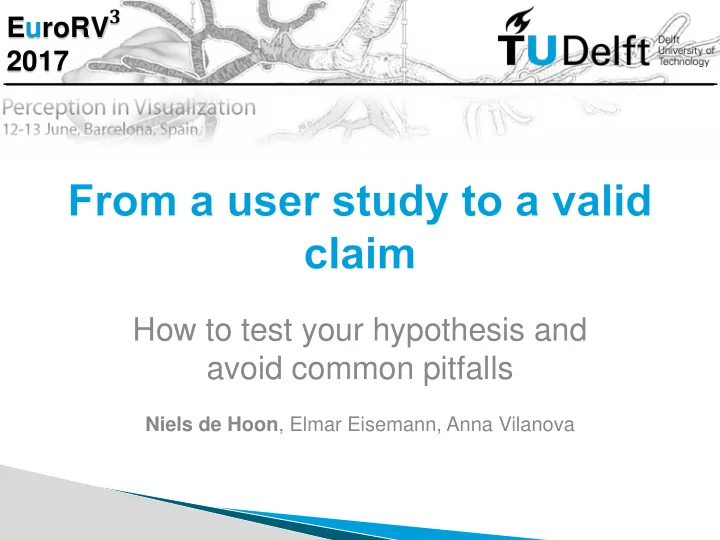

EuroRV 𝟒 2017 How to test your hypothesis and avoid common pitfalls Niels de Hoon , Elmar Eisemann, Anna Vilanova
EuroRV 𝟒 2017 Find support by means of a user evaluation for a claim made on a visualization An accessible summary of the statistical tools that can be used Common pitfalls and how to avoid them
EuroRV 𝟒 2017 User-based quality measures: • Perception • Effectiveness • Task performance
EuroRV 𝟒 2017 The number of user-based evaluations of visualizations has been increasing 1,2 Previous work indicates when 3,4 to perform a user study and how it should be conducted 5,6 1: Tory M., Möller T.: Human factors in visualization research. 2: Isenberg T., Isenberg P., Chen J., Sedlmair M., Möller T.: A systematic review on the practice of evaluating visualization. 3: Munzer T.: A nested model for visualization design and validation. 4: Smit N. N., Lawonn K.: An introduction to evaluation in medical visualization. 5: Gla β er S., Saalfeld P., Berg P., Merten N., Preim B.: How to evaluate medical visualizations on the example of 3d aneurysm surfaces. 6: Carpendale S.: Evaluating Information Visualizations
EuroRV 𝟒 2017 • Formulate a hypothesis • Define the user study • Find the right (amount of) participants • Conduct the user study • Statistical analysis
EuroRV 𝟒 2017 • Formulate a hypothesis We would like to reject the hypothesis (strongest conclusion) E.g.: in the justice system suspect = innocent Null hypothesis: suspect ≠ innocent Alternative hypothesis: We need enough evidence to reject the null hypothesis
EuroRV 𝟒 2017 • Formulate hypothesis By conducting the user study we want to find support for a claim that holds for our visualization Null hypothesis: Alternative hypothesis: Our technique State of the art Shape perception techniques
EuroRV 𝟒 2017 • Formulate hypothesis • Define the user study Questionaire? Task performance? Quantitative proof?
EuroRV 𝟒 2017 • Formulate hypothesis • Define the user study • Find the right (amount of) participants Domain experts/laymen? How many do we need? How many can we find?
EuroRV 𝟒 2017 • Formulate a hypothesis • Define the user study • Find the right (amount of) participants • Conduct the user study Question/Task User 1 User 2 … Question 1 4.2 4.5 Question 2 3.9 3.6 … Task 1 30.6 32.1 Task 2 15.9 14.3 …
EuroRV 𝟒 2017 • Formulate a hypothesis • Define the user study • Find the right (amount of) participants • Conduct the user study • Statistical analysis How do we show our experiment supports our claim?
EuroRV 𝟒 2017 Question/Task User 1 User 2 … Question 1 4.2 4.5 Question 2 3.9 3.6 … Task 1 30.6 32.1 Task 2 15.9 14.3 … Number of users State of the art Score Our technique
EuroRV 𝟒 2017 • Assume we have a user study with a small number of participants • The mean and variance are unknown • The distribution of the data is assumed to be a normal distribution
EuroRV 𝟒 2017 Describes the samples drawn from a normal distribution without knowledge on both the mean and variance Lower number of samples result in lower probabilities and a wider spread
EuroRV 𝟒 2017 From the distribution we can estimate for which we have 95% confidence the mean lies within this interval � ( 𝑒𝑒𝑒𝑒𝑒𝑒𝑒𝑒𝑒𝑒𝑒𝑒 ) = 0.95 Note: for the t -distribution the confidence interval will be bigger when less samples are available
EuroRV 𝟒 2017 State of the art Our technique
EuroRV 𝟒 2017 Assume 𝐼 0 is true Minimize the probability when redoing the experiment we find a value that is at least as extreme as the one we found This probability is the p -value Reduce the probability of a false positive
EuroRV 𝟒 2017 • The probability of a false positive should be small, e.g. we do not want to convict an innocent person • Stronger conclusion (more significant)
EuroRV 𝟒 2017 • When we cannot reject the null hypothesis, the null hypothesis is not necessarily true • In this case we lack evidence to reject the hypothesis • Therefore we fail to reject the hypothesis • This conclusion is weak, it is not the same as saying that it was proven, since it was only not disproved.
EuroRV 𝟒 2017 The hypothesis should be clear before the user study is conducted • Helps design the user study • Clear impact of questions on outcome • Helps to avoid fine tuning the hypothesis E.g.: Which shading technique provides a better shape perception
EuroRV 𝟒 2017 Be aware of the limitations of the data • A user study is a high level evaluation • Conclusions on underlying details can be difficult to derive E.g.: We cannot determine from a single user study why a technique works better
EuroRV 𝟒 2017 The hypothesis should be testable • The hypothesis should be based on something that can be measured • “Our tool increases productivity” instead of “Our tool encourages exploration”
EuroRV 𝟒 2017 The hypothesis be should supported by reason • Why a certain result is expected to be found • Reduces the probability of a false positive E.g.: Both techniques are intended to visualize shape
EuroRV 𝟒 2017 The number of hypotheses should be small • The probability of a false positive increases with the number of hypotheses
EuroRV 𝟒 2017 Find the right participants • Laymen opinions are less usable for domain specific tools • Attempt to sample the full user population E.g.: Laymen may be less familiar with NPR rendering techniques
EuroRV 𝟒 2017 Use the right number participants • Adding users to make results significant increases the probability of a false positive
EuroRV 𝟒 2017 N.H.L.C.deHoon@tudelft.nl
Recommend
More recommend